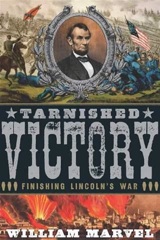Tarnished Victory: Finishing Lincoln’s War – Book Review
 Tarnished Victory: Finishing Lincoln’s War. William Marvel. Houghton Mifflin Harcourt, 2011. 370 pages of text, 14 pages of pictures, 6 maps, 52 pages of notes, and 31 pages of bibliography. Paperback. $35.00.
Tarnished Victory: Finishing Lincoln’s War. William Marvel. Houghton Mifflin Harcourt, 2011. 370 pages of text, 14 pages of pictures, 6 maps, 52 pages of notes, and 31 pages of bibliography. Paperback. $35.00.
Tarnished Victory is the fourth and last book in William Marvel’s series on the American Civil War, covering from May 1864 to June 1865. Like all the books in the series, the war is described as current events for the participants, civilian and military. While explanatory text provides context, the focus is on telling the story of people living in tumultuous times.
{default}The book opens with the sugaring season in western Maine, moves quickly to the Montana Territory’s miners, and then uses the Union military draft for 1864 as the connection to General Meade’s reorganization of the Army of the Potomac. I enjoyed the use of personal stories of the soldiers to describe larger events. For example, "Corps designation provided a more important part of Civil War soldiers’ identity than any other level of military unit except their regiment … many resented having to exchange it [their old corps badge] for the badge of a rival corps … reassigned to the Second Corps, at least half a dozen officers sewed its flannel trefoil badge on the seat of their pants. The Second Corps judge advocate subjected them all to court-martial, but a staff officer in the Second Corps sarcastically congratulated the disgruntled officers for wearing their badges on the portion of their anatomy that was always closest to the enemy."
Sticking close to personal stories shows how decisions affected soldiers and families. After men were informed of the start of a new campaign, all men, from generals to privates, wrote to their families "cautioning against undue distress over any lapse in correspondence." Soldiers’ wives and other civilians’ accounts about inflation and witch-hunts for traitors brings a focus on the home front that is missing from more military-oriented histories.
Marvel’s use of contemporary accounts provides a real feel of the fog of war and the limits of military intelligence and scouting in the Civil War. After Sherman took Atlanta, General Hood considered what to do to drive Sherman back north: "Intelligence of Sherman’s campaign to the coast, gleaned by scouts and confirmed by indiscreet Northern newspapers, did not reach Hood until the middle of November, by which time he had already undertaken an offensive into Tennessee."
1864 was a presidential election year and the Union armies poor showing in the previous years was reflected in President Lincoln’s reelection chances. New York Tribune editor Horace Greely castigated the President for being too hard on the Confederate peace feelers, while Republicans Benjamin Wade (U.S. Senator, Ohio) and Henry Winter Davis (U.S. Congressman, Maryland) "claimed that Lincoln had defied and usurped the authority of Congress with his rejection of their bill [for a punitive reconstruction policy]." Lincoln supporters were privately telling the President that it was unlikely he would be reelected. Lincoln prepared a "document that he asked his cabinet officers to endorse on the reverse, without allowing them to read it. Once they had signed, he sealed it tightly with glue and put it in his desk until the election. It pledged his cooperation with the new president-elect."
Today’s 24-hour news cycle was born with the telegraph providing a near real-time reporting of events as "Telegraph keys relayed confirmation of Atlanta’s fall as far as Washington and Grant’s headquarters late on the very night of its capture, and by morning it was all over the streets of New York." The speed of news influenced the very political nature of the Civil War. "The firmest War Democrats … recognized that the Shenandoah battles and fall of Atlanta sorely diminished George McClellan’s chances of winning the presidency."
While the book proper stops with the surrender of the Confederate armies and the mustering out of the Union Army of the Potomac, an epilog puts Marvel’s verdict on the Civil War with a quick overview through 1876. "Between 1865 and 1877 the nation’s leaders squandered the enormous sacrifices of Mr. Lincoln’s war, precisely as the early critics of a military solution had anticipated they would."
I enjoyed reading Marvel’s series and Tarnished Victory is a fitting capstone. Including much of the political, news media, social, and economic history without diminishing the military aspects of the Civil War is an impressive feat. This is a series that I strongly recommend for those looking for a concise, comprehensive look at the American experiences, Union and Confederate, during the Civil War. Readers wanting detailed military information on orders of battle, uniforms, etc. will have to refer to more specialized books.
Steven M. Smith has been an Armchair General contributor since 2010. He has a life-long interest in history especially the Napoleonic and Victorian periods. He was the owner of The Simulation Corner gaming retail outlet in Morgantown, West Virginia, until 1983. He is currently a member of the Historical Miniatures Gaming Society and works for Lockheed Martin in Baltimore, Maryland.


0 Comments
Trackbacks/Pingbacks